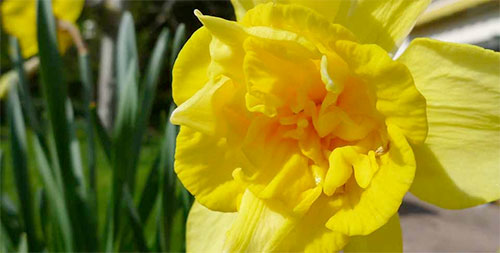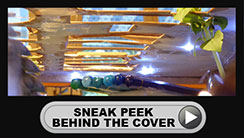
An enthusiastic, self-taught gardener, Tara Lissner is passionate about gardening and eager to share her zeal and knowledge with other gardening fans.
In 2012, she joined forces with Hester Macdonald, a British-trained landscape designer, to launch the Swiss Gardening School.
(Photo by Jean-Luc Pasquier)
Swiss Gardening School
www.swissgardeningschool.com

By Tara Lissner, Swiss Gardening School
Well we’ve been on a roller coaster with the weather over the past few weeks. The Indian summer lasted beautifully through the end of September and with the arrival of October the temperatures dropped and the bise wind rose. The tomatoes hung on to the bitter end but it is all over, the green ones are now in the kitchen in the hope that they may turn red but I predict an afternoon of green chutney making in my future.
This time of year is always bittersweet for the gardener, the glory of the summer garden has come to an end, the perennials have all gone to seed and while the seed-heads look wonderful the colour is slowly disappearing before us. Dahlias continue to perform and until we have consecutive nights of freezing temperatures they will continue to shine. It is a time to think about the future of course because this is the perfect time to add plants to the garden, trees, shrubs, hedges and perennials can all be planted until the freezing temperatures arrive. Have you got plans for trees, adding perennials? Take advantage of dry days to get out and make plans and plant them up, it is never nice to garden in the rain.
I’ve been busy this week, harvesting all the beans, I’ll be drying them out, shelling and storing them for use in soups and stews over the winter. I aways cut the plants to the ground, throwing them onto the compost, and leave the roots alone until the spring, this allows the nitrogen nodules along the fine roots of the beans plants to augment the nitrogen in the soil. I then cover the bed with about a 10 cms layer of mulch and leave that to work its way into the soil over the winter. Home made compost makes for a great mulch but it should be well broken down and at least a year old. If you don’t have any ready to go there are a number of places locally where you can buy it by the “big-bag” or have it delivered. I’ve used BGS Compost SA in Givrins, although closed on Saturdays it opens from 07:00 Monday to Friday.

By Tara Lissner, Swiss Gardening School
It is true that most of us who garden spend a fair amount of time discussing the weather; too hot; too dry; too windy; too wet; too wet; too wet. Well this summer we’ve certainly had a lot to discuss, with the incredibly wet and cool start in May and June to the tremendous heat of August – never a dull moment. Our gardens are so quickly affected by the changing weather conditions especially when it is holiday time and we are not on hand to adapt our habits day-by-day or week-by-week. In my experience it is always best to err on the side of caution and this is a perfect example of why. Early this summer I left half a dozen newly purchased perennial geraniums amongst a group of larger pots hoping they would be happy (and sheltered) enough during my week-long absence – I came home to crisp leaves and parched soil. I was so sad I immediately moved them to a more shady spot, drenched them with water and have been nursing them back to their original state ever since. Note to self, always pay a teenager to water even for a short trip.
The hydrangeas this summer have been just spectacular and although they need quite a lot of water, if they are in the correct position in the garden they will have given you quite the show. There has been a renaissance of the hydrangea in recent years with more and more varieties becoming easily available, this year I found a very pretty new (to me) variety called Hydrangea arborescens “Incredible Pink”. As the name suggests it is pink but not the bright showy pink of my childhood. Each petal is delicately edged in pink giving an overall dusty pink colour (see photo above) – just gorgeous, now all I have to do is find a reasonably shady spot for it in my garden, no easy feat.

By Tara Lissner, Swiss Gardening School
With the garden centres and DIY shops heaving with beautiful summer annual flowers, salad plug plants and vegetable plants it is understandable that you could be fooled into thinking that it is time to plant up the garden. But no, as the weather over the past few days has confirmed there is still time for snow and late frosts. When temperatures drop overnight to around zero significant damage may be done to immature and tender plants. Local advice dictates that nothing tender should be planted outside unprotected until after the days of the “ice saints”. These ice saints, Saint Mamertus, Saint Pancras and Saint Servatius, celebrate their feast days on 11, 12 and 13 May each year. Each year of course differs from the last and often temperatures are accommodating and we have no issues with chilly nights but when we do we really do. With temperatures due to stay low cover your veggie beds with horticultural fleece and move your pots next to the house for a little protection.
I am frequently asked what do with bulbs when the flowering has finished. Firstly and most importantly enjoy the flowers, whether you leave them in the garden or cut them for the house. The next tip is to dead head all the daffodils, only trim the flowering stem, this prevents the plant from producing seed. Allow the leaves to turn yellow, and I’m afraid this is where patience is necessary, the longer you wait the greater the show next year. When the leaves are limp and yellowed only then it is time to cut them back. Daffodils do very well when left in beds or naturalized in the lawn, tulips are a little more temperamental. In public spaces the tulips are always dug up, and new ones planted later in the year, this is not terribly practical or economic in a private garden. To get the best repeat show with tulips make sure they are well planted by December, three times the depth of the bulb, make a note in your garden notebook as to where they are (you will forget); there is nothing worse than digging up bulbs inadvertently when they are dormant in order to plant something else. Ensure the area does not dry out over the summer and don’t forget to fertilize the space with a general purpose fertilizer later in the year when all signs of the tulips have disappeared.

By Tara Lissner, Swiss Gardening School
What a wonderful September we’ve been enjoying. The summer heat may be long gone but gentle temperatures, sunshine and just a touch of rain are spoiling us. The soft September light sets off the brilliant colours of autumn; the orange, yellow and red of flowers, leaves and fruit – a beautiful time, a wonderful season. This time of year allows us to consider where we succeeded and where we need to concentrate our efforts while allowing us to get things into shape before the cold and dark days arrive. I’ve been working on a large plot, removing very old large growth, weeding a lot, turing the soil with the aid of a man with a digger, raking over again and again and finally covering the space with geotextile. Now all I have to do is make a plan for planting. Planning improves our chances of success. Take a close look at your garden and your vegetable garden, what worked, what failed, what did you really enjoy eating and what got left behind – each question has an answer and each answer allows for a change. Photographs also help with planning, take many and remind yourselves later in the year what you loved and what you can do without – make the change, easier said than done I realize but it is important to start.
At this time of year there is so much to do, in fact at almost every time of year there is so much to do. This is the time of that mad dash to get the garden ready for winter before you no longer want to step outside. Tidy up the flower beds, deadhead the blooms that have gone over, allowing energy to be directed to the remaining buds; keep on top of the weeding as weeds continue to grow well; lawn care and repair should be high on the to do list after our scorching summer. Plan some time to buy some bulbs, already now I hear you but yes already now. All local garden centres, DIY shops and even supermarkets carry a vast selection of bulbs. The best choice and the best quality is available now, don’t delay. They may be planted in borders, in the lawn or in pots and will give you tremendous joy in the spring when plants, trees and shrubs are dormant.

By Tara Lissner, Swiss Gardening School
We are putting the final touches to our autumn course timetable and are gently adding them to the website as details and locations are confirmed. This year we will launch a series of two-hour workshops at off-site locations beginning with "Designing with grasses" at the wonderful nursery Roussillon Fleurs in Meyrin later this month.
After a lovely long summer break I’m back to everything; back to school for the kids, back to early mornings for me, back to the overgrown and somewhat scorched garden and back to being alone in the morning when I can catch up on everything I didn’t get around to this summer. Sound familiar?
Summer brings with it so many distractions from the garden, holidays to take, guests to host, places to visit, people to see, meals to share. Short of harvesting the bounty from the garden this summer I managed to avoid doing much more than a lot of watering and a little weeding; the incredible and seemingly unending heat did not encourage me either. But now with September upon us and a most distinctive autumnal feel to the early dark mornings reality has set in – it’s back to work.









